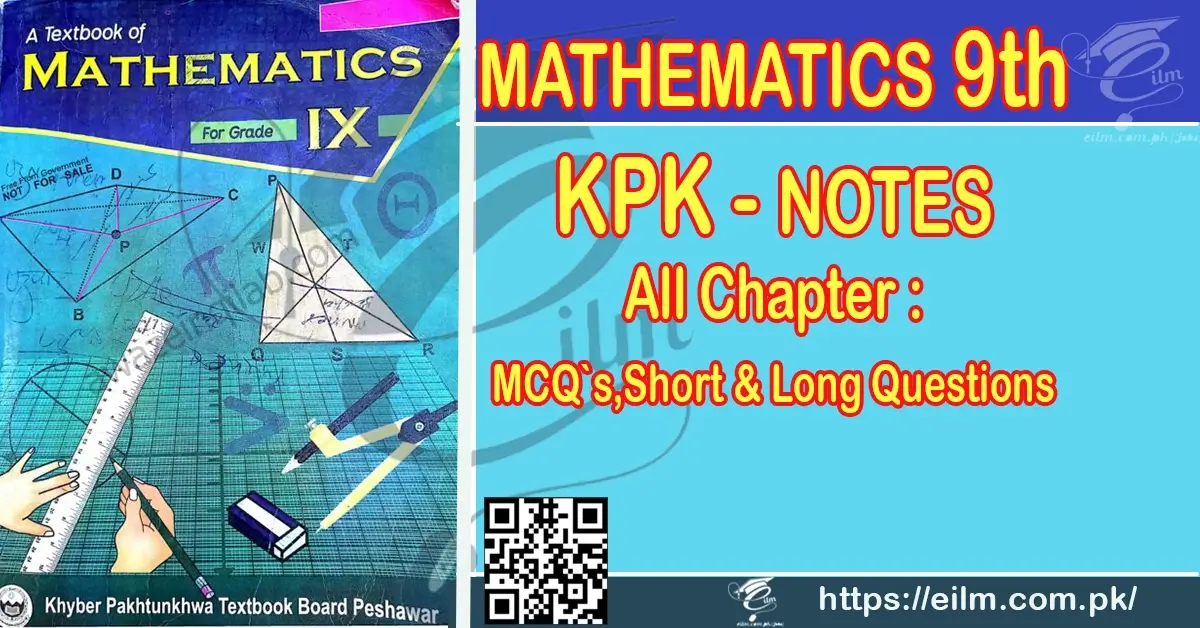Class 9 Physics For KPK MCQS, Short Questions and Long Questions Free PDF
Physics is one of the most important subjects in the curriculum of Class 9th in KPK, and students who excel in this subject often do well in other subjects too. As a result, it is essential to have a good understanding of the concepts of physics at this level. One of the best ways to achieve this is by studying from comprehensive Physics notes that cover all the topics and concepts of the subject. The notes prepared by Eilm physics experts completely covers KPK Bise syllabus and includes MCQS, Short questions and Long questions.
Class 9th KPK Physics Notes
The Class 9th KPK Physics Notes we provide, cover all the essential concepts of the subject, including Kinematics, Dynamics, Optics, Waves, and Electricity. Our notes are written in a comprehensive and easy-to-understand manner, making it easier for students to learn and retain the concepts effectively. 9th class physics notes are also designed to be self-sufficient, meaning that you do not need to refer to other textbooks or materials while studying. So follow these free class 9th physics notes to get good marks in BISE Exam.
“ Gaining knowledge ,is the first step to wisdom,Sharing it ,is the first step to Huminity”
Class 9th KPK Physics Notes Features and Benefits
Here are some of the key features and benefits of our Class 9th KPK Physics Notes:
Comprehensive Coverage:
Our notes cover all the topics and sub-topics of the Class 9th KPK Physics syllabus.
Clear and Concise Language:
Our notes are written in simple and easy-to-understand language, making it easier for students to learn and retain the concepts effectively.
Detailed Diagrams and Illustrations:
Our notes include detailed diagrams and illustrations that help students visualize the concepts and understand them better.
Practice Questions:
Our notes also include practice questions at the end of each chapter, which help students test their understanding of the concepts and prepare effectively for exams.
Class 9th Physics Notes KPK Board PDF Free Download
If you are a student of class 9th in KPK and searching for Physics notes to prepare for board exams, you can now find complete notes on EIlm.com.pk. These notes are based on the latest syllabus provided by the KPK Textbook Board curriculum and are prepared according to the paper pattern for class 9 Physics exams all over KPK. Physics class 9th kpk notes available at EIlm.com.pk are specifically prepared according to the latest SLO (Student Learning Outcome) examination syllabus. Students appearing in the following Boards of KPK can get consultation from these free class 9th math kpk notes.. With our notes, students can prepare for their exams confidently and perform well in their Physics exams.
- BISE Peshawar
- BISE Abbottabad
- BISE Bannu
- BISE Dera Ismail khan.
- BISE Kohat
- BISE Malakand
- BISE Mardan
- BISE Swat
KPK Class 9 Physics Chapter Wise Notes
Physics Notes Class 9 Chapter 1 Physical Quantities and Measurement
Are you struggling with physics in class 9? Look no further than our website for comprehensive notes on Chapter 1 – Physical Quantities and Measurement! Our physics notes for class 9th chapter 1 PDF and physics class 9 key book PDF will provide you with all the necessary knowledge to excel in your studies. From solved exercises to numericals, our physics notes for class 9th chapter 1 in Urdu and English have got you covered. Visit our website today and start your journey towards mastering physics!
- describe the crucial role of Physics in Science, Technology and Society.
- explain with examples that Science is based on physical quantities which consist of numerical magnitude and a unit.
- differentiate between base and derived physical quantities.
- list the seven units of System International (SI) along with their symbols and physical quantities (standard definitions of SI units are not required).
- interconvert the prefixes and their symbols to indicate multiples and sub-multiples for both base and derived units.
- write the answer in scientific notation in measurements and calculations.
- describe the working of Vernier Calipers and screw gauge for measuring length.
- identify and explain the limitations of measuring instruments such as meter rule, Vernier Calipers and screw gauge.
- describe the need using significant figures for recording and stating results in the laboratory.
Physics Notes (KPK) Class 9 Chapter 2 Kinematic
Meta description: Want to excel in your Physics Class 9 exams? Get access to comprehensive Physics notes (KPK) for Chapter 2 Kinematics on our website. Are you struggling with numericals? Our notes include solved numericals and exercise solutions. Download the Physics Class 9 Chapter 2 PDF, short questions and answers, and key book PDF. Our notes cover all the important topics, including Unit 2 Kinematics. Don’t miss out on the chance to ace your Physics exams with our expertly crafted notes.
- describe using examples how objects can be at rest and in motion simultaneously.
- identify different types of motion i.e. translator/, (linear, random, and circular); rotatory and vibratory motions and distinguish among them.
- differentiate with examples between distance and displacement, speed and velocity.
- differentiate with examples between scalar and vector quantities.
- represent vector quantities by drawing.
- define the terms speed, velocity and acceleration.
- plot and interpret distance-time graph and speed-time graph.
- determine and interpret the slope of distance time and speed-time graph.
- determine from the shape of the graph, the state of a body
- at rest
- moving with constant speed
- moving with variable speed.
- calculate the area under speed-time graph to determine the distance travelled by the moving body.
- derive equations of motion for a body moving with uniform acceleration in a straight line using graph.
- solve problems related to uniformly accelerated motion using appropriate equations.
- solve problems related to freely falling -2 bodies using 10 ms as the acceleration due to gravity.
Physics Class 9th (KPK) Chapter 3 Dynamics
After studying this unit, the students will be able to:
- define momentum, force, inertia, friction and centripetal force.
- solve problems using the equation Force = change in momentum / change in time.
- explain the concept of force by practical examples of daily life.
- state Newton’s laws of motion.
- distinguish between mass and weight and solve problems using F= ma, and w = mg. calculate tension and acceleration in a string during motion of bodies connected by the string and passing over frictionless pulley using second law of motion.
- state the law of conversation of momentum.
- use the principle of conservation of momentum in the collision of two objects.
- determine the velocity after collision of two objects using the law of conservation of momentum.
- explain the effect of friction on the motion of a vehicle in the context of tyre surface, road conditions including skidding, braking force.
- demonstrate that rolling friction is much lesser than sliding friction.
- list various methods to reduce friction.
- explain that motion in a curved path is due to a perpendicular force on a body that changes direction of motion but not speed.
- calculate centripetal force on a body moving in a 2 circle using mv /r.
- state what will happen to you while you are sitting inside a bus when the bus.
Chapter 4 Physics Class 9th Turning Effect of Forces
After studying this unit, the students will be able
- state head to tail rule of vector addition of forces/vectors.
- describe how a force is resolved into its perpendicular components.
- determine the magnitude and direction of a force from its perpendicular components.
- define moment of force or torque as moment = force x perpendicular distance from pivot to the line of action of force.
- explain the turning effect of force by relating it to everyday life.
- state the principle of moments.
- define the centre of mass and centre of gravity of a body.
- define couple as a pair of forces tending to produce rotation.
- prove that the couple has the same moments about all points.
- define equilibrium and classify its types by quoting examples from everyday life.
- state the two conditions for equilibrium of a body
- solve problems on simple balanced systems when bodies are supported by one pivot only.
- describe the states of equilibrium and classify them with common examples.
- explain effect of the position of the center of mass on the stability of simple objects.
Unit 5 Gravitation Class 9th Physics KPK Notes
- state Newton’s law of gravitation.
- explain that the gravitational forces are consistent with Newton’s third law.
- explain gravitational field as an example of field of force.
- define weight (as the force on an object due to a gravitational field.)
- calculate the mass of Earth by using law of gravitation.
- solve problems using Newton’s law of gravitation.
- explain that value of g decreases with altitude from the surface of Earth.
- discuss the importance of Newton’s law of gravitation in understanding the motion of satellites.
Class 9th Physics Chapter 6 Work and Energy
- define work and its SI unit.
- calculate work done using equation
- Work = force x distance moved in the direction of force
- define energy, kinetic energy and potential energy. State unit of energy.
- prove that kinetic energy K.E. = mv and potential energy P.E. = mgh. Solve problems using these equations.
- list the different forms of energy with examples.
- describe the processes by which energy is converted from one form to another with reference to
- state mass energy equation E = mc and solve problems using it.
- describe the process of electricity generation by drawing a block diagram of the process from fossil fuel input to electricity output.
- list the environmental issues associated with power generation.
- explain by drawing energy flow diagrams through steady state systems such as filament lamp, a power station, a vehicle travelling at a constant speed on a level road.
- differentiate energy sources as non renewable and renewable energy sources with examples of each. define efficiency of a working system and calculate the efficiency of an energy conversion using the formula: efficiency = energy output converted into the required form / total energy input
- explain why a system cannot have an efficiency of 100%.
- define power and calculate power from the formula: Power = work done / time taken
- define the unit of power “watt” in SI and its conversion with horse power.
Physics Class 9th (KPK) Chapter 7 Properties of Matter
- state kinetic molecular model of matter (solid, liquid and gas forms).
- describe briefly the fourth state of matter i.e. Plasma.
- define the term density.
- compare the densities of a few solids, liquids and gases.
- define the term pressure (as a force acting normally on unit area).
- explain how pressure varies with force and area in the context of everyday examples.
- explain that the atmosphere exerts a pressure.
- describe how the height of a liquid column may be used to measure the atmospheric pressure.
- describe that atmospheric pressure decreases with the increase in height above the Earth’s surface. explain that changes in atmospheric pressure in a region may indicate a change in the weather.
- state Pascal’s law.
- apply and demonstrate the use with examples of Pascal’s law.
- state relation for pressure beneath a liquid surface to depth and to density i.e., (P=pgh) and solve problems using this equation.
- state Archimedes principle.
- determine the density of an object using Archimedes principle.
- state the upthrust exerted by a liquid on a body.
- state principle of floatation. explain that a force may produce a change in
Chapter 8 Thermal Properties of Matter Class 9th Physics Notes KPK
- define temperature (as quantity which determines the direction of flow of thermal energy).
- define heat (as the energy transferred resulting from the temperature difference between two objects). list basic thermometric properties for a material to construct a thermometer.
- convert the temperature from one scale to another (Fahrenheit, Celsius and Kelvin scales).
- describe rise in temperature of a body in terms of an increase in its internal energy.
- define the terms heat capacity and specific heat capacity.
- describe heat of fusion and heat of vaporization (as energy transfer without a change of temperature for change of state).
- describe experiments to determine heat of fusion and heat of vaporization of ice and water respectively by sketching temperature-time graph on heating ice.
- explain the process of evaporation and the difference between boiling and evaporation.
- explain that evaporation causes cooling.
- list the factors which influence surface evaporation.
- describe qualitatively the thermal expansion of solids (linear and volumetric expansion).
- explain thermal expansion of liquids (real and apparent expansion).
- solve numerical problems based on the mathematical relations learnt in this unit
Chapter 9 Transfer of Heat Physics Class 9th KPK
- recall that thermal energy is transferred from a region of higher temperature to a region of lower temperature.
- describe in terms of molecules and electrons , how heat transfer occurs in solids.
- state the factors affecting the transfer of heat through solid conductors and hence, define the term Thermal Conductivity.
- solve problems based on thermal conductivity of solid conductors.
- write examples of good and bad conductors of heat and describe their uses.
- explain the convection currents in fluids due to difference in density.
- state some examples of heat transfer by convection in everyday life.
- explain that insulation reduces energy transfer by conduction.
- describe the process of radiation from all objects.
- explain that energy transfer of a body by radiation does not require a material medium and rate of energy transfer is affected by:
- colour and texture of the surface
- surface temperature
- surface area
Class 10th Notes Punjab Board


Join EILM.COM.PK Learning Program











